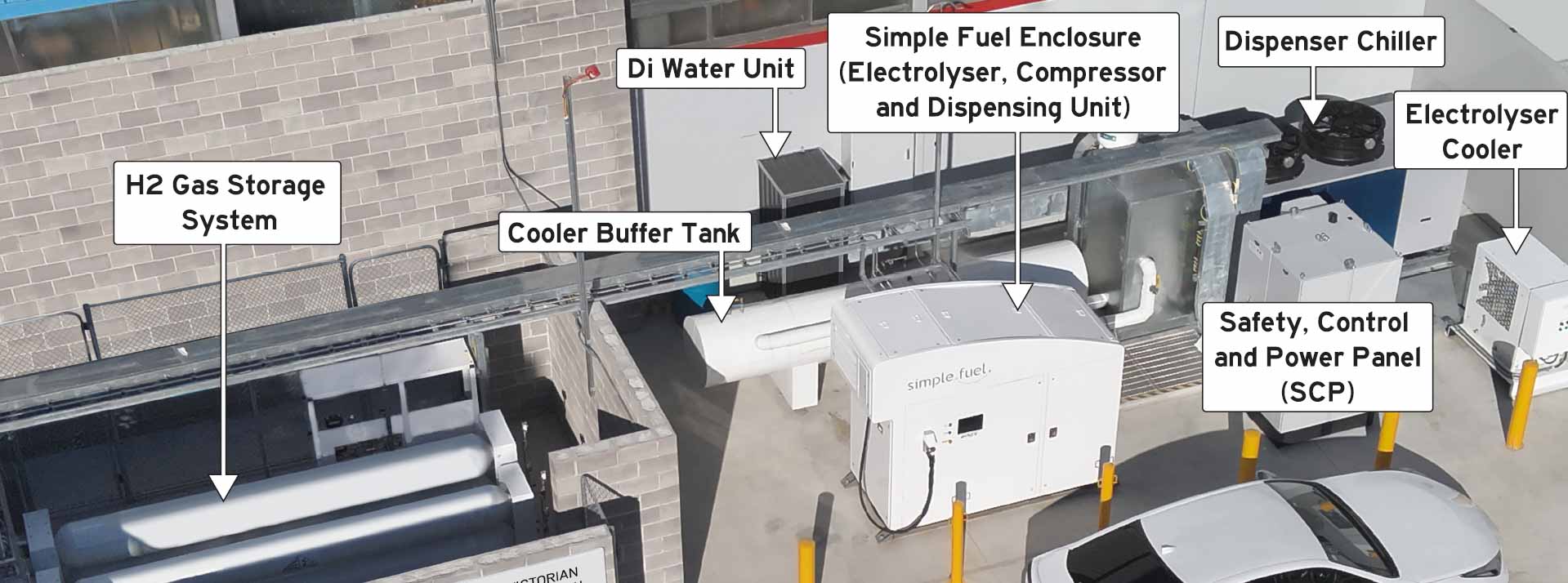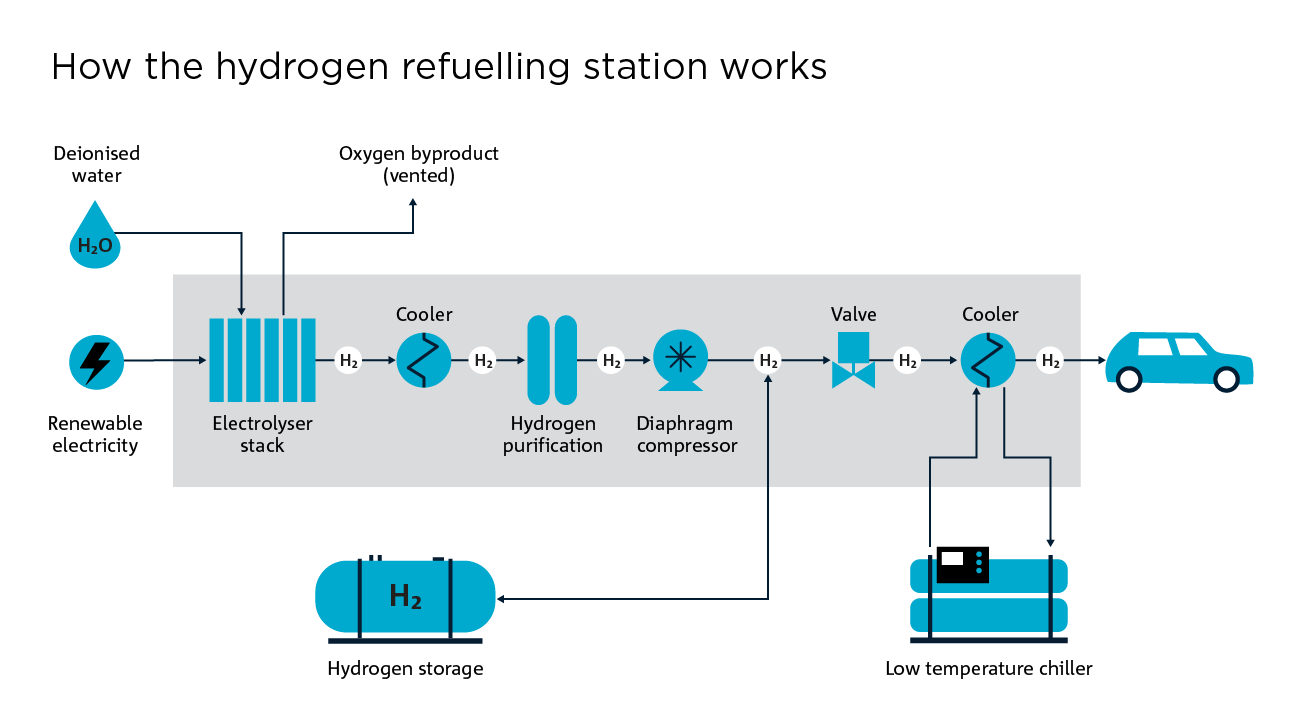
Our hydrogen refuelling station is a computer-controlled system consisting of six main components:
- Three in one unit comprising an electrolyser, compressor and 700 bar hydrogen dispensing system to fuel a hydrogen car
- FIBA hydrogen storage pressure vessels (x6) for storage of hydrogen at high pressure
- Deionisation subsystem for water purification
- Gordon Brothers chiller system for cooling hydrogen down to -40oC
- Electrolyser cooler for removing excess heat from the electrolysis process
- Safety, control and power unit which controls all the logic, safety alarms and power.
The flow chart below shows how the components work together to produce hydrogen and refuel cars:

Electrolyser and Compressor
The Proton Exchange Membrane (PEM) electrolyser inside the central unit marked as SimpleFuel is used to convert deionised water into hydrogen and oxygen, using ‘green’ electricity purchased from the state grid. It can produce 20kg of hydrogen per day. The hydrogen then goes through to the compressor, which pressurises it to 1000 bar (14,503 psi), before sending it to one of the storage tanks.Hydrogen Storage
There are six horizontal storage cylinders totalling 80kg of storage. The cascade hydrogen system requires that some hydrogen is stored at 1000 bar, some at 700 bar and some at at 500 bar. These different pressures are used to fill the hydrogen vehicle via a computer-controlled protocol to 700bar.
Current hydrogen cars such as Toyota Mirai & Hyundai Nexo can store up to 6 kgs of hydrogen at this standardised 700 bar pressure. The vehicles have a driving range of around 600km.
Chiller
As fast filling of hydrogen results in heat being generated during the depressurising phase (when filling a vehicle), the gas entering the vehicle tanks must be precooled. The chiller is used to cool the hydrogen gas down to –40oC.
Our chiller was constructed by an Australian supplier.
Dispenser
To dispense hydrogen, the user connects the nozzle to the vehicle and then presses the vehicle fill button on the bowser.
The vehicle and the hydrogen refueller use a standard based Protocall to talk to each other and perform the pre-fill safety checks, which include a connection seal check. Only after all the checks are completed will the refueller start the fuelling stage.
Filling a vehicle is computer controlled, where the computer can speed up or slow down the filling process depending on the temperature in the vehicle's tank. Typically, with hydrogen gas precooled to –40oC, a vehicle can be filled from empty in under 10 minutes.
The computer system is constantly monitoring the filling process and no further intervention is needed by the user. Once the filling is complete the user is prompted to remove the nozzle from the vehicle and return it to its location.
The Hydrogen Refuelling Station is designed to refuel cars with a 700 bar storage tank.
Safety documentation
CSIRO staff can access all the safety documentation for the hydrogen refuelling station in our safety platform, Donesafe (RIS50018).
Our hydrogen refuelling station is a computer-controlled system consisting of six main components:
- Three in one unit comprising an electrolyser, compressor and 700 bar hydrogen dispensing system to fuel a hydrogen car
- FIBA hydrogen storage pressure vessels (x6) for storage of hydrogen at high pressure
- Deionisation subsystem for water purification
- Gordon Brothers chiller system for cooling hydrogen down to -40oC
- Electrolyser cooler for removing excess heat from the electrolysis process
- Safety, control and power unit which controls all the logic, safety alarms and power.
The flow chart below shows how the components work together to produce hydrogen and refuel cars:
Flowchart showing how the hydrogen refuelling station works
Electrolyser and Compressor
The Proton Exchange Membrane (PEM) electrolyser inside the central unit marked as SimpleFuel is used to convert deionised water into hydrogen and oxygen, using ‘green’ electricity purchased from the state grid. It can produce 20kg of hydrogen per day. The hydrogen then goes through to the compressor, which pressurises it to 1000 bar (14,503 psi), before sending it to one of the storage tanks.Hydrogen Storage
There are six horizontal storage cylinders totalling 80kg of storage. The cascade hydrogen system requires that some hydrogen is stored at 1000 bar, some at 700 bar and some at at 500 bar. These different pressures are used to fill the hydrogen vehicle via a computer-controlled protocol to 700bar.
Current hydrogen cars such as Toyota Mirai & Hyundai Nexo can store up to 6 kgs of hydrogen at this standardised 700 bar pressure. The vehicles have a driving range of around 600km.
Chiller
As fast filling of hydrogen results in heat being generated during the depressurising phase (when filling a vehicle), the gas entering the vehicle tanks must be precooled. The chiller is used to cool the hydrogen gas down to –40oC.
Our chiller was constructed by an Australian supplier.
Dispenser
To dispense hydrogen, the user connects the nozzle to the vehicle and then presses the vehicle fill button on the bowser.
The vehicle and the hydrogen refueller use a standard based Protocall to talk to each other and perform the pre-fill safety checks, which include a connection seal check. Only after all the checks are completed will the refueller start the fuelling stage.
Filling a vehicle is computer controlled, where the computer can speed up or slow down the filling process depending on the temperature in the vehicle's tank. Typically, with hydrogen gas precooled to –40oC, a vehicle can be filled from empty in under 10 minutes.
The computer system is constantly monitoring the filling process and no further intervention is needed by the user. Once the filling is complete the user is prompted to remove the nozzle from the vehicle and return it to its location.
The Hydrogen Refuelling Station is designed to refuel cars with a 700 bar storage tank.
Safety documentation
CSIRO staff can access all the safety documentation for the hydrogen refuelling station in our safety platform, Donesafe (RIS50018).
